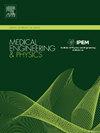The influence of boiling bubble on the acoustic field and bubble dynamics in histotripsy: A numerical investigation
IF 2.3
4区 医学
Q3 ENGINEERING, BIOMEDICAL
引用次数: 0
Abstract
Boiling histotripsy (BH) is a non-invasive treatment technique that leverages cavitation effects to disintegrate soft tissue. However, the influence of boiling bubble on the acoustic field and bubble dynamics, which are key mechanisms underlying tissue destruction in BH, is not yet fully understood. This study aims to elucidate the acoustic field distribution and dynamics of a single bubble, demonstrate the generation of intrinsic cavitation bubbles, and predict the associated cavitation damage using a numerical model. The Westervelt equation was employed to simulate the nonlinear propagation of ultrasound pulses in biological tissues, considering varying boiling bubble sizes at the focus and initial acoustic pressures on the transducer surface. Moreover, the Keller-Miksis equation model, combined with the Voigt model, was used to simulate the nonlinear oscillation of bubbles. The presence of a boiling bubble results in significant acoustic reflection at the bubble interface, particularly a notably strong negative pressure. Simulation results show that intrinsic cavitation occurs in a bubble radius of 0.4 mm at an initial acoustic pressure of 2 MPa. Increasing the boiling bubble radius to 1.1 mm leads to the extension of cavitation bubbles toward the second layer of the standing wave field. Additionally, the initial acoustic pressure seems to influence intrinsic cavitation more significantly than the boiling bubble radius. Bubble dynamics, including its maximum bubble radii and expansion duration, is significantly affected by the rarefactional wave. This effect is attributed not only to the peak negative pressure but also to the waveform. In conclusion, the presence of a boiling bubble at the focus substantially modifies the acoustic field distribution, the formation of intrinsic cavitation clouds, and the characteristics of bubble dynamics. The boiling bubble radius and the initial acoustic pressure on the transducer surface are critical factors in modifying cavitation-associated tissue fractionation. Appropriate parameter settings for ultrasonic pulses may enhance the efficacy and reduce the potential complications in BH treatment.
沸腾气泡对声场及气泡动力学的影响:数值研究
煮沸组织术(煮沸组织术)是一种利用空化效应分解软组织的非侵入性治疗技术。然而,沸点气泡对声场和气泡动力学的影响是BH中组织破坏的关键机制,目前还没有完全了解。本研究旨在阐明单个气泡的声场分布和动力学,展示固有空化气泡的产生,并利用数值模型预测相关的空化损伤。考虑焦点处沸腾气泡大小和换能器表面初始声压的变化,采用Westervelt方程模拟超声脉冲在生物组织中的非线性传播。此外,采用Keller-Miksis方程模型结合Voigt模型对气泡的非线性振荡进行了模拟。沸腾气泡的存在导致气泡界面产生明显的声反射,特别是明显的强负压。仿真结果表明,在初始声压为2 MPa的条件下,气泡半径为0.4 mm处出现本征空化现象。当沸腾泡半径增大到1.1 mm时,空化泡向驻波场第二层扩展。此外,初始声压似乎比沸腾气泡半径对固有空化的影响更显著。气泡动力学,包括气泡的最大半径和膨胀持续时间,受反射波的显著影响。这种影响不仅归因于峰值负压,也归因于波形。综上所述,焦点处沸腾气泡的存在极大地改变了声场分布、本征空化云的形成以及气泡动力学特征。沸腾气泡半径和传感器表面的初始声压是改变空化相关组织分馏的关键因素。适当的超声脉冲参数设置可以提高治疗BH的疗效,减少潜在的并发症。
本文章由计算机程序翻译,如有差异,请以英文原文为准。
求助全文
约1分钟内获得全文
求助全文
来源期刊

Medical Engineering & Physics
工程技术-工程:生物医学
CiteScore
4.30
自引率
4.50%
发文量
172
审稿时长
3.0 months
期刊介绍:
Medical Engineering & Physics provides a forum for the publication of the latest developments in biomedical engineering, and reflects the essential multidisciplinary nature of the subject. The journal publishes in-depth critical reviews, scientific papers and technical notes. Our focus encompasses the application of the basic principles of physics and engineering to the development of medical devices and technology, with the ultimate aim of producing improvements in the quality of health care.Topics covered include biomechanics, biomaterials, mechanobiology, rehabilitation engineering, biomedical signal processing and medical device development. Medical Engineering & Physics aims to keep both engineers and clinicians abreast of the latest applications of technology to health care.
 求助内容:
求助内容: 应助结果提醒方式:
应助结果提醒方式:


